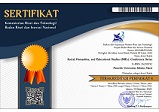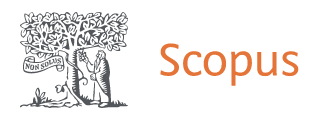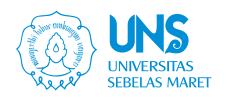Pendekatan STEAM Berbasis Etnosains Tanaman Kopi Desa Tapak Gedung Kepahiang
Abstract
The STEAM (Science, Technology, Engineering, Arts, and Mathematics) approach based on ethnoscience is increasingly relevant in the educational context of Indonesia, particularly in culturally rich areas such as Tapak Gedung Village, Kepahiang Regency. The objective of this research is to explore the effectiveness of this approach in enhancing students' understanding of coffee plants as a local commodity. The method employed is a literature review, encompassing critical analysis regarding the integration of scientific knowledge and cultural values. The results indicate that the combination of STEAM elements and ethnoscience not only enhances students' comprehension of scientific concepts but also fosters cultural awareness and collaborative skills. The conclusion highlights that this approach has the potential to empower local communities and create a more meaningful and relevant learning experience, as well as develop critical thinking skills essential for the 21st century.
Pendekatan STEAM (Sains, Teknologi, Teknik, Seni, dan Matematika) berbasis etnosains semakin relevan dalam konteks pendidikan di Indonesia, terutama di daerah kaya budaya seperti Desa Tapak Gedung, Kabupaten Kepahiang. Tujuan penelitian ini adalah untuk mengeksplorasi efektivitas pendekatan tersebut dalam meningkatkan pemahaman siswa tentang tanaman kopi sebagai komoditas lokal. Metode yang digunakan adalah tinjauan literatur, yang mencakup analisis kritis terkait integrasi ilmu pengetahuan dan nilai budaya. Hasil menunjukkan bahwa penggabungan elemen STEAM dan etnosains tidak hanya meningkatkan pemahaman siswa tentang konsep ilmiah, tetapi juga membangun kesadaran budaya dan keterampilan kolaboratif. Simpulan menunjukkan bahwa pendekatan ini memiliki potensi untuk memberdayakan komunitas lokal dan menciptakan pengalaman belajar yang lebih bermakna dan relevan, serta mengembangkan keterampilan berpikir kritis yang diperlukan di abad ke-21.
Keywords
Full Text:
PDFReferences
Alfayanti, A., Rosmanah, S., Fauzi, E., Hidayat, T., & Wahyuni, T. (2022). Pengetahuan dan respon petani terhadap teknologi budidaya kopi robusta (studi kasus desa sidorejo kecamatan kabawetan kabupaten kepahiang). Prosiding Seminar Nasional Universitas Pgri Palangka Raya, 1, 45-53. https://doi.org/10.54683/puppr.v1i0.7
Atmaja, I., Nyoman, I., & Sukewijaya, I. (2025). Unveiling the secrets of arabica coffee: how cultivation methods impact quality and chemical composition. International Journal of Multidisciplinary Research and Analysis, 08(05). https://doi.org/10.47191/ijmra/v8-i05-36
Cahyono, E. A., Sutomo, N., & Hartono, A. (2019). Literatur Review; Panduan Penulisan Dan Penyusunan. Jurnal Keperawatan, 12(2), 12-12.
Colodetti, T., Rodrigues, W., Cavatte, P., Reis, E., Filho, A., Brinate, S., … & Tomaz, M. (2020). Managing the number of orthotropic stems in coffea arabica as strategy for cultivation at low-altitude regions. Australian Journal of Crop Science, (14(03):2020), 447-454. https://doi.org/10.21475/ajcs.20.14.03.p1986
Ehrenbergerová, L., Klimková, M., Cano, Y., Habrová, H., Lvončík, S., Volařík, D., … & Maděra, P. (2021). Does shade impact coffee yield, tree trunk, and soil moisture on coffea canephora plantations in mondulkiri, cambodia?. Sustainability, 13(24), 13823. https://doi.org/10.3390/su132413823
Fitch, G., González, J., Oana, A., Oliver, M., & Vandermeer, J. (2022). Integrating effects of neighbor interactions for pollination and abiotic resources on coffee yield in a multi‐strata agroforest. Biotropica, 54(5), 1226-1237. https://doi.org/10.1111/btp.13145
Hao, K., Liu, X., Wang, X., Fei, L., Liu, L., Jie, F., … & Shan, Y. (2022). Optimizing shade cultivation method and irrigation amount to improve photosynthetic characteristics, bean yield, and quality of coffee in a subtropical monsoon climate. Frontiers in Plant Science, 13. https://doi.org/10.3389/fpls.2022.848524
Lima, A., Guimarães, R., Cunha, S., Castro, E., Carvalho, A., & Faria, M. (2021). Seedling production of coffea arabica from different cultivars in a modified hydroponic system and nursery using different containers. Ciência E Agrotecnologia, 45. https://doi.org/10.1590/1413-7054202145017821
Lima, J., Blanco, A., Falcão, H., Machado, S., & Miguel, K. (2023). Occurrence of mycotoxin-producing fungi in coffee beans marketed in goiás.. https://doi.org/10.56238/devopinterscie-230
Listyati, D., Sudjarmoko, B., Hasibuan, A., & Randriani, E. (2017). Analisis usaha tani dan rantai tata niaga kopi robusta di bengkulu. Jurnal Tanaman Industri Dan Penyegar, 4(3), 145. https://doi.org/10.21082/jtidp.v4n3.2017.p145-152
Martínez-Ruiz, Y., Duque, D., Gómez, J., & Ramírez-Malule, H. (2022). Evaluation of energy potential from coffee pulp in a hydrothermal power market through system dynamics: the case of colombia. Sustainability, 14(10), 5884. https://doi.org/10.3390/su14105884
Nascimento, L., Assis, G., Fernandes, M., Caixeta, L., Carvalho, F., & Mazziero, B. (2023). Morphology of the coffee root system using polyethylene film. Revista Ceres, 70(4), 33-41. https://doi.org/10.1590/0034-737x202370040006
Nyaruai, C., Ollengo, M., & Muthakia, G. (2024). Iridescent patterns production from solid film cellulose nanocrystals prepared from coffee husks. Univers. J. Carbon Res., 107-123. https://doi.org/10.37256/ujcr.2120244851
Okoli, C., & Schabram, K. (2010). A guide to conducting a systematic literature review of information systems research. Sprouts: Working Papers on Information Systems, 10(26), 1–51.
Padidi, N., Wisdawati, E., & Baba, B. (2024). Formulasi pupuk organik limbah kulit kopi dengan penambahan tanaman penghasil nitrogen terhadap pertumbuhan bibit kopi robusta (coffea canephora l.). Agroplantae Jurnal Ilmiah Terapan Budidaya Dan Pengelolaan Tanaman Pertanian Dan Perkebunan, 13(1), 82-91. https://doi.org/10.51978/agro.v13i1.811
Rosniawaty, S., Ariyanti, M., Sudirja, R., Mubarok, S., & Saragih, E. (2018). Respon tanaman kopi muda terhadap pemberian jenis bahan organik yang berbeda. Agrosintesa Jurnal Ilmu Budidaya Pertanian, 1(2), 71. https://doi.org/10.33603/.v1i2.1929
Sari, R., Marliah, A., & Hereri, A. (2019). Pengaruh komposisi media tanam dan dosis npk terhadap pertumbuhan bibit kopi robusta (coffea chanephora l.). Jurnal Agrium, 16(1), 28. https://doi.org/10.29103/agrium.v16i1.1339
Sidabalok, J. and Herawati, M. (2023). Pengaruh perbandingan media tanam terhadap hasil pertumbuhan stek batang tanaman kopi robusta (coffea canephora) pada fase pembibitian. Prosiding Seminar Nasional Pembangunan Dan Pendidikan Vokasi Pertanian, 4(1), 733-739. https://doi.org/10.47687/snppvp.v4i1.697
Widiyani, D., Gusta, A., Aziz, A., Usodri, K., Hartono, J., & Hamdani, H. (2022). Identifikasi hubungan iklim mikro pada tanaman kopi robusta (coffea chanepora) dataran rendah. Jurnal Agrinika Jurnal Agroteknologi Dan Agribisnis, 6(2), 151-160. https://doi.org/10.30737/agrinika.v6i2.2774
Yusnia, Y., Johan, S., Stiadi, E., & Agusdianita, N. Literasi Budaya dan Kewargaan Berbasis Budaya Lokal Tradisi Sekujang Desa Tapak Gedung Kepahiang. In Social, Humanities, and Educational Studies (SHES): Conference Series (Vol. 7, No. 3).
Refbacks
- There are currently no refbacks.





